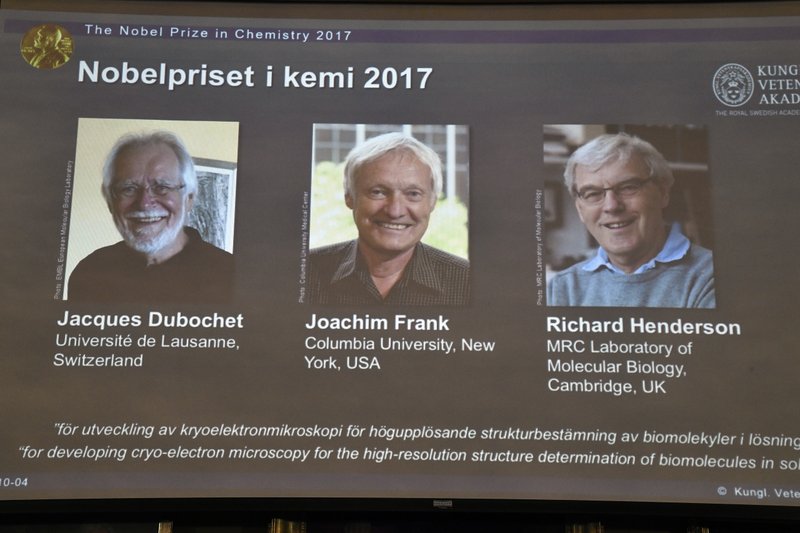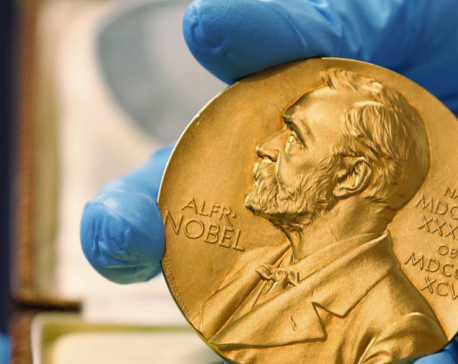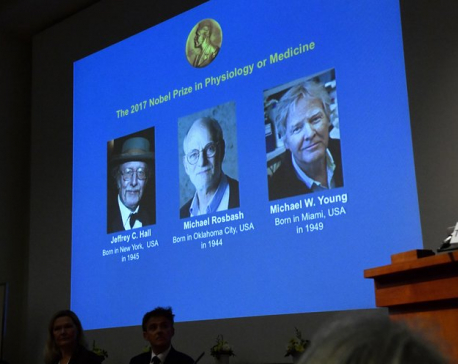
OR
Nobel Prize honors technique for seeing molecules’ details
Published On: October 4, 2017 04:24 PM NPT By: Associated Press

STOCKHOLM, Oct 4: Three researchers based in the U.S., U.K. and Switzerland won the Nobel Prize in Chemistry on Wednesday for developments in electron microscopy.
The 9-million-kronor ($1.1 million) prize is shared by Jacques Dubochet of the University of Lausanne, Joachim Frank at New York’s Columbia University and Richard Henderson of MRC Laboratory of Molecular Biology in Cambridge, Britain.
The Royal Swedish Academy of Sciences said their method, called cryo-electron microscopy, allows researchers to “freeze biomolecules” mid-movement and visualize processes they have never previously seen.
The development, it said, “is decisive for both the basic understanding of life’s chemistry and for the development of pharmaceuticals.”
The annual prize rewards researchers for major advances in studying the infinitesimal bits of material that are the building blocks of life.
Recent prizes have gone to scientists who developed molecular “machines” — molecules with controllable motions — and who mapped how cells repair damaged DNA, leading to improved cancer treatments.
It’s the third Nobel announced this week.
The medicine prize went to three Americans studying circadian rhythms: Jeffrey C. Hall, Michael Rosbash and Michael W. Young. The physics prize went to Rainer Weiss, Barry Barish and Kip Thorne for detecting gravitational waves.
The literature winner will be named Thursday and the peace prize will be announced Friday.
You May Like This

The Latest: 3 share Nobel physics prize for gravity waves
STOCKHOLM, Oct 3: The Latest on the Nobel Physics Prize (all times local): ... Read More...

3 Americans win Nobel medicine prize for body rhythm work
STOCKHOLM, Oct 2: The Nobel Prize in Physiology or Medicine was awarded to three Americans on Monday for discoveries about... Read More...

Swedish Academy says Bob Dylan won't attend Nobel prize ceremony
American singer-songwriter Bob Dylan, who was awarded the Nobel Prize in Literature last month, has decided not to attend the... Read More...






Just In
- Nepalgunj ICP handed over to Nepal, to come into operation from May 8
- Nepal to gift two elephants to Qatar during Emir's state visit
- NUP Chair Shrestha: Resham Chaudhary, convicted in Tikapur murder case, ineligible for party membership
- Dr Ram Kantha Makaju Shrestha: A visionary leader transforming healthcare in Nepal
- Let us present practical projects, not 'wish list': PM Dahal
- President Paudel requests Emir of Qatar to initiate release of Bipin Joshi
- Emir of Qatar and President Paudel hold discussions at Sheetal Niwas
- Devi Khadka: The champion of sexual violence victims



_20240423174443.jpg)









Leave A Comment